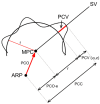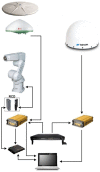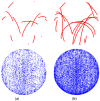Preliminary Results of an Astri/UWM EGNSS Receiver Antenna Calibration Facility
- PMID: 34300379
- PMCID: PMC8309558
- DOI: 10.3390/s21144639
Preliminary Results of an Astri/UWM EGNSS Receiver Antenna Calibration Facility
Abstract
In 2019, the University of Warmia and Mazury in Olsztyn, in cooperation with Astri Polska, started a European Space Agency (ESA) project. The purpose of the project is the development and implementation of a field calibration procedure for a multi-frequency and multi-system global navigation satellite system (GNSS). The methodology and algorithms proposed in the project are inspired by the "Hannover" concept of absolute field receiver antenna calibration; however, some innovations are introduced. In our approach, the antenna rotation point is close to the nominal mean phase center (MPC) of the antenna, although it does not coincide with it. Additionally, a National Marine Electronics Association local time zone (NMEA ZDA) message is used to synchronize the robot with the GNSS time. We also propose some modifications in robot arm movement scenarios. Our first test results demonstrate consistent performance for the calibration strategy and calibration procedure. For the global positioning system (GPS) L1 frequency, the calibration results show good agreement with the IGS-type mean values. For high satellite elevations (20°-90°), the differences do not exceed 1.5 mm. For low elevation angles (0°-20°), the consistency of the results is worse and the differences exceed a 3 mm level in some cases.
Keywords: GNSS; PCC; antenna calibration.
Conflict of interest statement
The authors declare no conflict of interest.
Figures









References
-
- Baire Q., Bruyninx C., Legrand J., Pottiaux E., Aerts W., Defraigne P., Bergeot N., Chevalier J.M. Influence of different GPS receiver antenna calibration models on geodetic positioning. GPS Solut. 2013;18:529–539. doi: 10.1007/s10291-013-0349-1. - DOI
-
- Dawidowicz K., Krzan G. Analysis of PCC model dependent periodic signals in GLONASS position time series using Lomb– Scargle periodogram. Acta Geodyn. Geomater. 2016;13:299–314. doi: 10.13168/AGG.2016.0012. - DOI
-
- Gorres B., Campbell J., Becker M., Siemes M. Absolute calibration of GPS antennas: Laboratory results and comparison with field and robot techniques. GPS Solut. 2006;10:136–145. doi: 10.1007/s10291-005-0015-3. - DOI
Grants and funding
LinkOut - more resources
Full Text Sources

